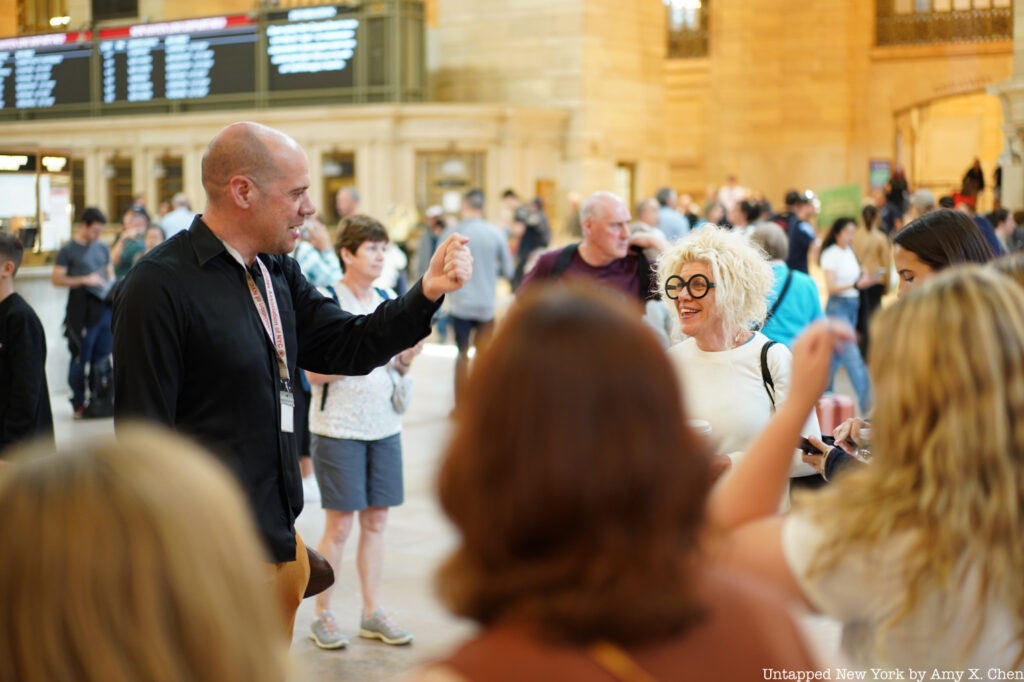Grand Central’s clock, located in the center of the famous train terminal in Manhattan, is so famous it even supposedly birthed a saying: “Meet me at/under the clock.” Countless commuters have used the Grand Central clock, located in the atrium between track 27/28 on one end and Vanderbilt Hall on the other, to denote where to meet in Grand Central. The four-faced Grand Central clock is at once a beautiful object to behold, a masterpiece of functionality, and the bearer of many myths and secrets. One of the most famous myths, reproduced on countless websites and television programs, is patently false: No, the Grand Central clock is not worth $20 million. It’s not the “priceless jewel hidden in plain sight.” Here’s why.
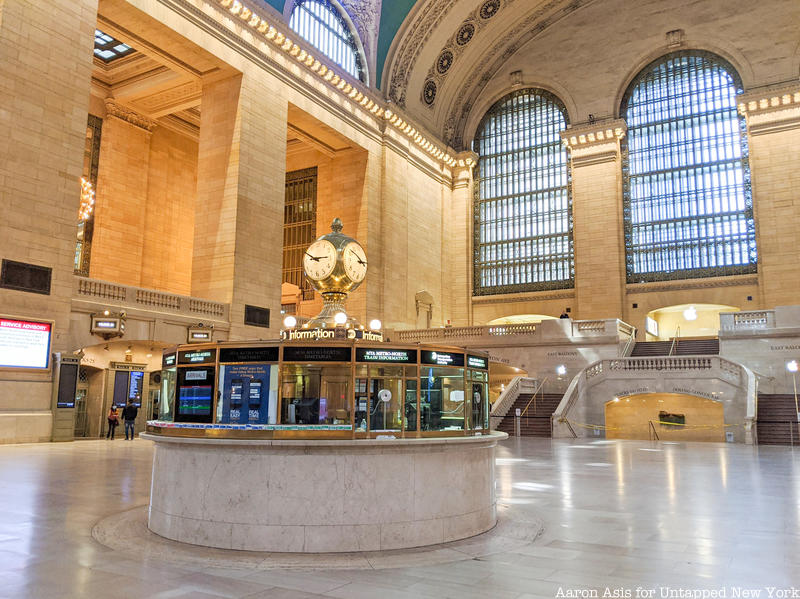
Where the Grand Central Clock Myth Comes From
The root of the myth comes from the supposed material of the clock faces, often erroneously said to be of opal or “solid opal.” The appearance of this claim can be traced back to at least March 7, 1999, when the Associated Press published the article “Celebrating New York City’s Unique Public Spaces” that was syndicated in newspapers all across the country for the next two months. “The clock with an opal face that has been a meeting place for generations of New Yorkers,” it proclaimed. On March 5, 2000, an Arizona Daily Star stated that the clock faces “are polished from precious opal.”
Later that decade, a Wikipedia user edited the Grand Central Terminal page on May 18, 2006 (at 2:17 PM to be exact). The user specifically added, “Each of the four clock faces are made from Opal and both Sotheby’s and Christie’s have estimated the value to be between ten and twenty million dollars.” The Wikipedia user, identified only by the user’s IP address, 216.179.65.2 which can be traced to Croton-on-Hudson, New York, essentially made this update about Grand Central’s clock, the last of a few minor updates to the main Grand Central Terminal Wikipedia entry, and never appeared on Wikipedia again.
The supposed valuation of the clock also appeared in newspapers within the next month, including a reference in an article by the Dallas Morning News that was syndicated nationally by McClatchy-Tribune News Service, which cites information gleaned from the official Grand Central tour. The article states that “each face of the brass clock atop the information booth clock is made of solid opal and the four faces are valued at $20 million.” From there, the myth shows up in many more major publications through the present day. Wikipedia editors changed the sentence in 2013 to say the story was an urban legend, a line that was also subsequently removed on August 10, 2020 citing a lack of sources for the claim.
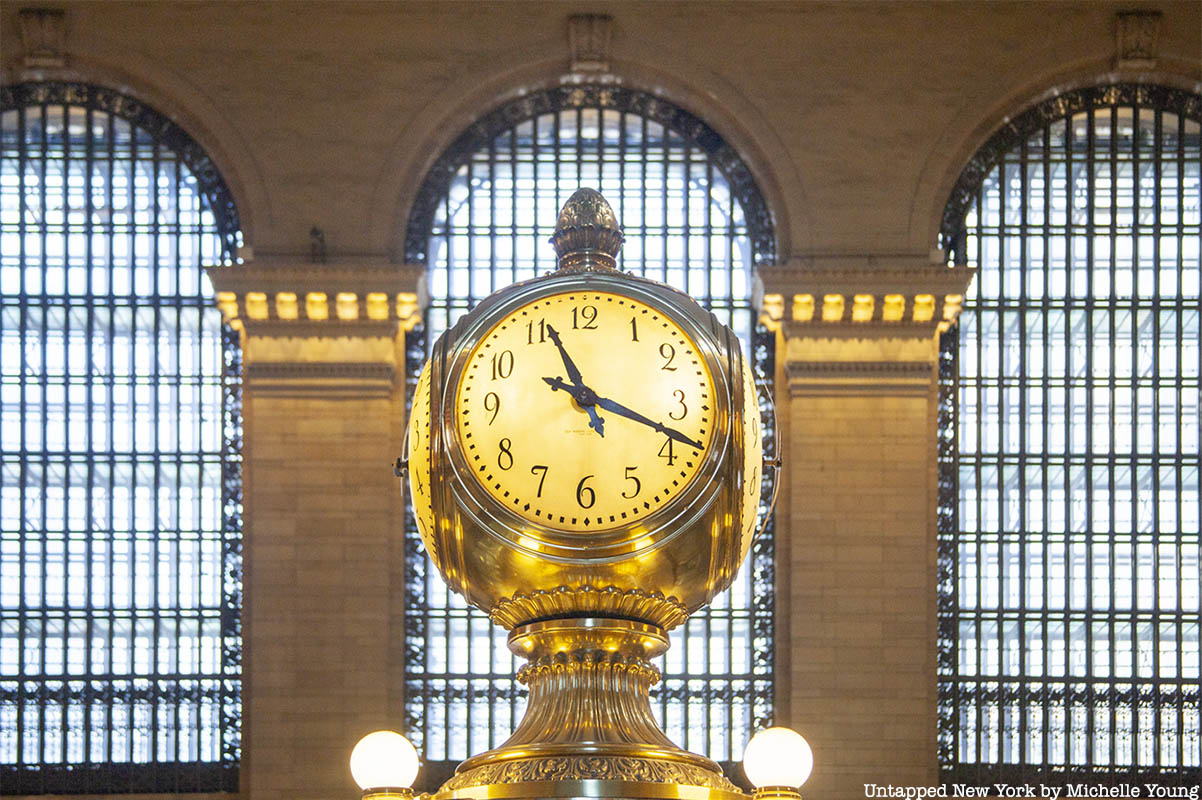
Someone who also promulgated the myth of Grand Central’s clock was Daniel Brucker, the former docent-in-chief at Metro-North who gave off-limits tours of Grand Central until he was let go for running them. Brucker worked for Metro-North starting in 1987 and was frequently interviewed on television and by news publications. On a tour we took in 2015, he stated the clock was worth between $10 to $20 million. Brucker similarly promoted a myth that a train car underneath the Waldorf-Astoria was used by President Franklin Delano Roosevelt. While FDR did take his own train into Grand Central, it is not the same car that sat for many years on Track 61. We traveled to see this train car, which is now in the Danbury Railway Museum in Connecticut and documented to our readers how it had always been a mundane tool car and that FDR’s limousine would have been too large to make it inside.
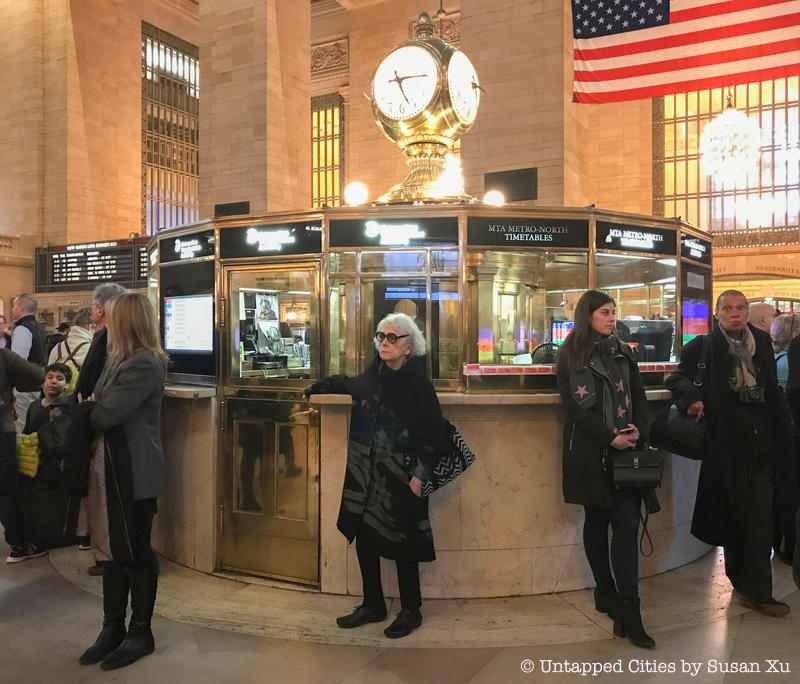
But back to the Grand Central clock. It was designed by Henry Edward Bedford, a sculptor and executive of the Self Winding Clock Company which built the clock with assistance from the Seth Thomas Clock Company, which made the movements. The Self Winding Clock Company also created the clocks in Grand Central Terminal’s predecessor, Grand Central Station. In a letter dated November 9, 1886, J.M. Toucey, the General Superintendent of the New York Central & Hudson River Railroad Company praised a clock that had been purchased from the Self Winding Clock Company for Grand Central Station: “Replying to your inquiry, would say that the large Self Winding Clock purchased from you…for our Incoming Passenger Station has never failed to wind, and has proven entirely satisfactory. The small Regulator you placed in this office in June has performed equally well.”
Looking back at historical documentation, a 1954 New York Times article reporting on the restoration of the current clock in the atrium describes the faces of the clock as just “glass,” not opal. The clock had been taken in for repair at the Self Winding Clock Company’s factory at 205 Willoughby Avenue in Brooklyn (next to Pratt Institute) for the first time because its movements had become unpredictable or “eccentric,” as the Times described it. Sometimes it was so off that the staff in Grand Central had to literally throw a large paper bag over it to prevent people from missing their trains. A photograph that accompanies the Times article shows two men removing the clock faces and temporary clocks placed on a box around the clock. A sign reads, “Please bear with us as the ball clock is being repaired”
The 23-page interior landmark designation report on Grand Central by the Landmarks Preservation Commission in 1980 merely says that “The Main Concourse desk is topped by a handsome four-faced bronze clock.” The official book about Grand Central’s centennial, Grand Central Terminal: 100 Years of a New York Landmark by historian Anthony Robins and the New York Transit Museum describes the clock as having “opaline glass” faces. This material is also called “milk glass” or “opal glass.” One can see where the confusion may have originated from, but opal glass is not actually made from any opal.
Opal glass has its origins in Venice during the 16th century, developed as a translucent alternative to porcelain, and began to be referred to as “opal glass” in the 19th century. According to the company Garbo Glassware, “Opal glass is made of the addition of bone ash, tin dioxide, or antimony compounds, which are also sometimes added to ceramic glazes to produce a milky white color. Opal glass is referred to as milk glass, although milk glass is a relatively new term.” The use of opal glass became especially popular in the Gilded Age, so it’s not surprising that the Vanderbilts and their set would have opted for an opal glass clock as the centerpiece of the Grand Central atrium.
Journalist Sam Roberts, also describes the clock as a “four-faced opalescent glass clock” in his book Grand Central: How a Train Station Transformed America. (He does also say however, that the Grand Central clock is “priceless” — mixing a little of the myth in). Even more interesting is what happened to the Grand Central clock in the spring of 1968. According to Roberts, one of the clock faces was “pierced by a bullet —apparently fired by a police officer in pursuit of the ‘yippies’ from the Youth International Party who were staging a ‘yip-in’ in Grand Central.” When police went after then with nightsticks, they “hurled firecrackers and spun the hands off” the clock.
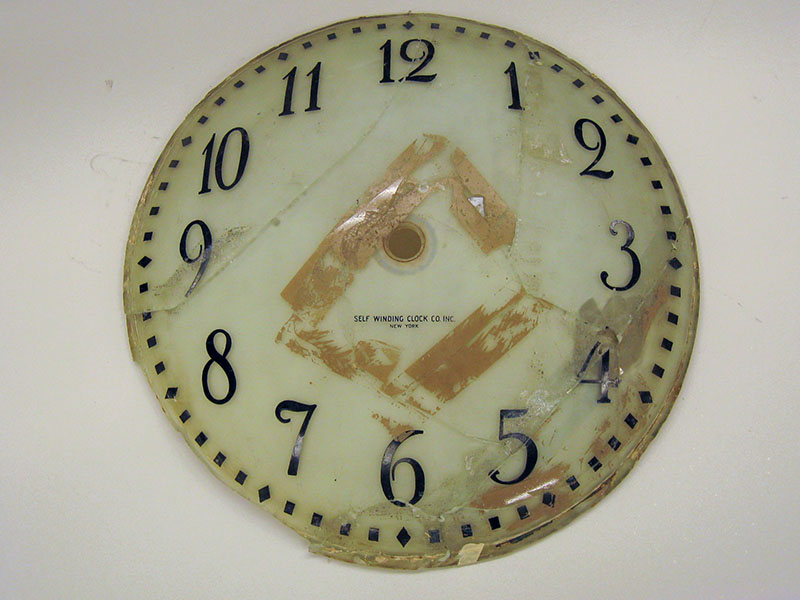
The damaged clock face actually remained in use through the 1980s, and was only removed when restoration to Grand Central Terminal began. It is now in the collection of the New York Transit Museum. The convex shape of the clock face is apparent — it is certainly not solid anything, let alone solid opal. The item’s description in the museum’s catalog record resolves all questions: “Opal glass convex circular Clock Face removed from four-sided admiralty brass ball clock with acorn finial above information kiosk in center of Grand Central Terminal main concourse during restoration. Clock face was replaced due to damage (cracked and bullet- or bb-shot marked).” In addition, a spokesperson for Metro North confirmed for us that the clock is indeed opaline glass, not opal. We have also reached out to both Christie’s and Sotheby’s for comment on whether any valuation had taken place on the clock.
So while this investigation resolves the major longstanding myth about the Grand Central clock, there are more myths and secrets to it:
Myth about “Meet me under the clock”
Turns out the phrase “Meet me at the clock” or “Meet me under the clock” may not have first originated with the Grand Central clock. According to Mandy Edgecombe, Grand Central tour guide for Untapped New York and a former National Park Ranger, the first “meet me at the clock” referred to the clock in the former Hotel Astor in Times Square. Then the 1945 Judy Garland and Robert Walker movie, The Clock put the longstanding tradition of meeting for dates at the Hotel Astor clock on the national stage. Soldier Joe, played by Walker meets Garland’s Alice by chance in old Penn Station, leading to a love story that happens in many iconic locations in New York City. “Where will I meet you?” asks Joe, to which Alice responds, “Under the clock at the Astor at seven.”
Then it was the clock at the original Pennsylvania Station that became associated with “Meet me under the clock.”. The Waldorf=Astoria Hotel came into the game too, popularized by the song “Meet Me at the Hyphen,” as well as the Biltmore Hotel and the Roosevelt Hotel. It’s certainly a phrase that can be attached to any clock!
Secret: There’s a Hidden Staircase inside the Information Booth
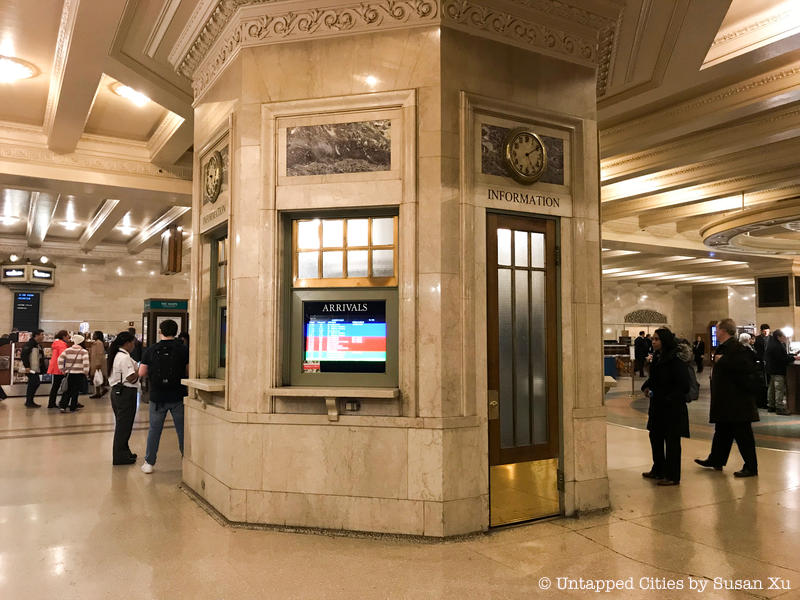
There is a hidden staircase inside the center information kiosk in the atrium which goes down to the lower concourse level. Beneath the feet of the Metro North workers is a trap door, under which extends a spiral brass staircase. It is said that it’s a quick way for workers to go between levels, but in fact, before 9/11, there was no entrance to the kiosk on the main concourse level. After 9/11, the door was added in case of emergency. Besides the metal banisters, it’s not very fancy inside, and one of the few photographs out there shows a worn-down chair, a fan, a garbage can, and a portrait of Jesus.
Secret: Sometimes the Four Clock Faces Would Have Different Times
Grand Central was the first railroad station in the nation to adopt standard time in 1883. But before 2004, the roughly 1,000 clocks in the terminal would still have to be manually adjusted. Twice a year, all the clocks would have to shift to account for Daylight Savings time, a particularly “onerous challenge,” writes Roberts who recounts the story of Jacob Bachtold, the Swiss immigrant known as “Jake the Clock Man” who worked for the railroad for fifty years. Despite the skill of people like Jacob, the clocks in Grand Central often contradicted each other — even the four clock faces on the information booth didn’t have the same time.
In 2004, all the clocks in the terminal were synchronized to Grand Central’s master clock currently found on the Lower Level by Track 117. This master clock is synchronized every second by a signal from an atomic clock at the Naval Observatory in Bethesda, Maryland. This master clock controls the time at every other official clock in the terminal.
Secret: Look Closely at Metro North Employee Jackets and Shirts
The Metro North employee jackets and shirts have the Grand Central clock logo on them and the time is set to 19:13 in military time, the year the terminal opened. This logo was also on the Grand Central centennial materials.
The valuation and opal material of the Grand Central clock is not the only myth about the famous terminal. You may have heard about the hole in the atrium ceiling said to be caused by the display of a Redstone rocket on display was too tall. Every claim has some reference to a “hapless” engineer, some mention that he forgot to bring his tape measurer. To disprove it, we compared the official measurements of all the Redstone rockets to the ceiling height of Grand Central’s atrium— none would have come close. Turns out the hole was created to enable a wire to stabilize the rocket.
Grand Central Terminal is a beloved landmark in New York City. Its creation was a feat probably only achievable by Gilded Age industrialists like Cornelius Vanderbilt II and William K. Vanderbilt, who sat on the board of the railroad, along with William P. Rockefeller and J.P. Morgan, and the daring engineering ingenuity of chief railroad engineer William J. Wilgus. Then, through its narrow escape from demolition and subsequent rebirth in a glorious restoration, the train terminal entered an almost hallowed place in the city’s collective memory. When that happens, myths abound. The internet has become a prime disseminator of false claims that become even harder to dispel. With this probe into the Grand Central clock, we hope we have re-entered some of its truths into the public record.
A special thank you to Bill Burns, Meredith Daniels with the MTA/Metro-North, Chelsea Newburg at the New York Transit Museum, Justin Rivers and Mandy Edgecombe from Untapped New York for their assistance on this article.
Next, check out Inside the Grand Central Lost and Found!







